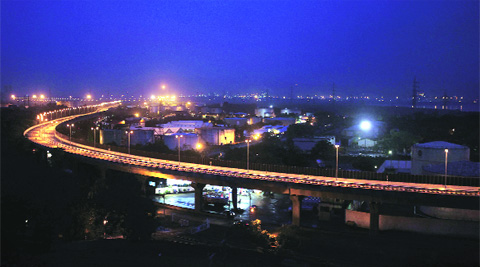- India
- International
A seaside dream faces real test
The 28-km-long strip of land snaking along the city’s eastern coast has failed to keep pace with rest of the city.
 The recently constructed Eastern Freeway cuts through the strip of land.
The recently constructed Eastern Freeway cuts through the strip of land.
As the rest of the city grew organically from a 19th-century colonial port city of traders, which soon spawned a textile industry, to become the country’s financial nerve-centre, this 28-km-long strip of port trust land snaking along the eastern coast of Mumbai refused to keep pace with the changing urbanscape. This, even as the symbiotic relationship between Mumbai and its port was severed over the last three decades, once the action moved to the Jawaharlal Nehru Port Trust (JNPT). For long, the land remained sequestered from the consciousness of the bustling city that lay outside its perimeter.
For the land mass which, in its geographical expanse accounts for 1/8th of the total area of island city of south Mumbai and is worth tens of thousands of crores of rupees in real estate terms, authorities have surprisingly managed to fend off attempts by various interest groups for so long. According to a 2013 World Bank working paper, even if less than a third of the entire land is capitalised on, it will yield about Rs 1.25 lakh crore. The paper, though, does strike a cautionary note, “The financial value of port land need not dictate decisions about land use.”
Now, finally the Mumbai Port Trust (MbPT) has acceded to the demands of a city whose crumbling infrastructure is wrecked further by its unsustainable density. Of the total 1790 acres, about 1200 acres from Colaba to Wadala in the island city will be available for the city’s use. The port activities, along with the sub-optimally used warehouses and container storage facilities, will be consolidated on parts of land, freeing up the rest for infrastructure, recreation, tourism and housing.
The experts, which comprise the Land Development Committee (LDC) set up by Union Shipping and Transport Minister Nitin Gadkari, have come up with a wide range of suggestions for regenerating the land sprawl. While the finer details are still a work in progress, the panel has drawn up a preliminary note that will form the conceptual foundation of the report to be submitted to the ministry soon.
THE GRAND PLANS
Spatially, the revival plans aim to integrate the stretch with the rest of the city by throwing open its until-now inaccessible waterfront even while preserving sites that are of heritage and ecological value. On the infrastructure front, the panel has proposed three additional north-south mass transit systems along the route, including a bus rapid transport system (BRTS), metro rail project and water transport network for intra-city and inter-city travel to Revas, Mandwa, Murud, Nerul and Alibaug. These would be complemented with ample parking facilities and station area traffic improvement schemes for inter-modal transport. While the Development Plan of the municipal corporation has reserved merely one per cent of the land for open spaces, the panel has recommended that a third of the total available land i.e. about 400 acres of open space, be used as gardens, playgrounds, plazas and sports facilities.

It has been suggested that another 300 acres be kept aside for entertainment and tourism purposes. The ambitious plans that are under deliberation include construction of showcase projects such as aquarium and water theme parks along the lines of Sea-world, a Disney World Mumbai, theme pavilions along waterfront and fountains with LED lights. The port trust’s own plans for a flotel and floating restaurants, cruise terminal, helipad, marina, sea-food courts and special trade zone will also be included in LDC’s recommendation.
The panel will also address more looming concerns such as creating rental housing, with defined densities, for the working classes “to serve the larger housing need of the city”. Another Herculean task would be rehabilitating the squalid slum sprawls that have mushroomed along the coastline and are sustained by the informal jobs allied to port activities. Since the land belongs to a central government agency, these thousands of slums could neither be eligible for rehabilitation nor for basic amenities such as water supply, sanitation, healthcare centres or municipal schools. Even though they have been inhabiting the land for several decades now, there is no proper documented record of their numbers. The panel has now recommended that these be housed vertically along with the necessary social and physical infrastructure. The mechanism for the rehabilitation is yet to be drawn up since the developer-driven Slum Rehabilitation Schemes has been categorically ruled out in keeping with Gadkari’s statement that not an inch of land would be given to private builders.
“We want to ensure this doesn’t turn into another land grab by builders. Even the rehabilitation of the eligible slum-dwellers should be done by a public authority,” said Shiv Sena MP Arvind Sawant under whose constituency a majority of the land falls.
However, the panel is yet to come up with a plan to rehabilitate the slum-dwellers in terms of jobs as one of their primary means of livelihood, the environmentally hazardous ship-breaking, is planned to be moved out of city limits. “The slum residents are mostly engaged in ship-breaking and allied activities such as forging the scrap metal to make hammers, nuts and bolts. They have subsisted and remained competitive, thanks to the very informality of livelihood,” says a panel member.
Generation of jobs would be another focus area as articulated in the panel’s draft note that pegs the target for the year 2034 at half-a-million jobs with a special focus on youth. To this effect, the panel has recommended establishing Entrepreneurship Promotion Zones and support for jobs in small and medium scale enterprises that will rehabilitate the existing industries on the land.
An international finance centre with convention centre and exhibition hall has also been proposed at the Elphinstone Estate, which currently houses warehouses with short lease tenure, iron-steel and transport offices and footpaths lined with hutments. Sources say that Raghuram Rajan, Governor of the Reserve Bank of India, has also requested for some space for the apex bank’s operations in this particular parcel. Other proposed facilities are Export Promotion Zones, Maharashtra Business Promotion centres along with allied hospitality facilities.
ROADBLOCKS AHEAD
The grandiose plans, however, are beset with just as many hurdles that bog down any other brownfield project. There are 3,000-odd lessees occupying 47 per cent of the total land. A majority of these have managed to hold on to the land owing to stay orders procured from court despite the leases having expired long ago. MbPT chairman RM Parmar says the agency will abide by the 2004 Supreme Court judgment that approved the compromise formula drawn up by the port trust. “Accordingly, we will renew the long-term leases and co-opt them as important stakeholders. As for those who are unauthorised sub-lessees or those who have discontinued using the premises for the purpose it was allotted for, we will initiate eviction under the Public Premises Act,” he says while conceding that the process, however, is expected to be a protracted one.
Only five per cent of the lease-held land is vacant with 68 per cent on long-lease and the remaining on a tenure of one to 15 months. There is also the issue of polluting and toxic activities such as ship-breaking and loading and unloading of cargo such as rock phosphate and coal.
The panel is exploring the possibility of shifting out such activities while allowing basic ones such as ship-repairs and oil filling tanks to continue. The rock phosphate is transported to the Rashtriya Chemicals and Fertilizers Limited in Chembur and there have been demands to shift the polluting plant itself to some place in Alibaug. Before any project is undertaken for urban renewal, the panel has suggested that bio-remediation be carried out to remove the toxic residues.
MANY A SLIP
Despite public disclaimers by politicians, lessons from the past have shown that when such large parcels of land are freed, there are many a slip between the plans for infrastructure, open spaces and social housing that are drawn up on paper and what actually mushrooms on ground in the form of high-rise commercial complexes, shopping malls and super-luxury residential towers.
This was evident most starkly in case of the mills land, where as per initial plans, 400 acres of the total 600 acres spread over 54 defunct mill lands were to be used as gardens, parks, playgrounds and for affordable housing. Through a sleight of hand in 2001, the Maharashtra government allowed mill owners to part with only two-thirds of the open spaces on their land instead of two-third of the entire plot. This left the city with a mere 50 acres scattered over small plots while private mill owners sold off much of the land at rates that propelled Mumbai’s realty market to stratospheric heights and choked its already strained infrastructure further.
In case of the MbPT land too, earlier attempts to plough the land back to cater to the city’s basic needs have failed to materialise despite a state-commissioned vision plan that was brought out more than a decade ago. While much of the LDC’s recommendations seem promising on paper, the devil lies in policy formulation and its implementation. Apart from its strategic location along the waterfront in the island city, the land is also well serviced by the harbour line railway trains and the recently constructed Eastern Freeway and will also be the landing site of the Sewri Nhava Sheva Trans harbour link for easy access to Navi Mumbai. Fears about it transgressing into real estate ventures, hence, are not misplaced.
MBPT’s Parmar, who is also the member-secretary of the LDC, says the panel is deliberating about setting up a Special Planning Authority dedicated to planning and implementing its recommendations. “Urban planning is not the core competency of MbPT, which is why there is a need for a separate institutional mechanism to execute the plans,” he says.
Similar agencies have been instrumental in the evolution of dynamic bay cities. Some of these include the London Docklands Development Corporation (LDDC), which steered the metamorphosis of Canary Wharf region, a once the colonial trading hub, into complexes meant for offices, public services and housing. Similar development bodies include the Merseyside Development Corporation in Liverpool in Britain, the Cardiff bay Development Corporation in Wales and Rotterdam City Development Corporation in Netherlands.
However, the European context of port land development was much distinct from that of Mumbai. In case of the former, the aim was reinvention of derelict and mostly vacant port areas. On the other hand, in Mumbai, the port land will be used to recompense for the excesses of the rest of the city. The development here is dictated by pressing needs of a full-to-the-brim city, marred by issues of multiple claimants and threatened by high land values in a space-starved city.
shalini.nair@expressindia.com
Apr 26: Latest News
- 01
- 02
- 03
- 04
- 05







































